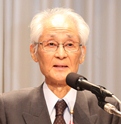Toshimichi Okubo --- His Personality and Determination to Build a Modern State
September 07, 2011
Mr. Toshihiro Okubo
Executive Director, Kasumi Kaikan
 ��Professor Emeritus Banno at the University of Tokyo (modern Japanese political history) wrote an article in the Tokyo Shimbun dated September 4th: ��Time calls for a strategist like Okubo, not a revolutionist like Saigou. Prime Minister Noda should follow Okubo��s model. Okubo visited as many as 70 factories in Europe and promoted the Japanese industry upon return. He took the lead in the business world.��
��Professor Emeritus Banno at the University of Tokyo (modern Japanese political history) wrote an article in the Tokyo Shimbun dated September 4th: ��Time calls for a strategist like Okubo, not a revolutionist like Saigou. Prime Minister Noda should follow Okubo��s model. Okubo visited as many as 70 factories in Europe and promoted the Japanese industry upon return. He took the lead in the business world.��
��Toshimichi Okubo was assassinated on May 14th, 1878. He happened to receive a guest that morning and left the following words, which became his will: ��The first 10 years of the Meiji era was turbulent and unproductive for me. For the coming 10 years, we must address domestic policies and fortify our national strength based on commercial industry. I am determined to commit myself to this task. After that, I will transfer the task to the younger generation and watch over them.�� What did Toshimichi envision as the basis of ��modern state��?
1. Educating the Emperor
��Toshimichi felt the need to re-establish the Imperial family, so that it would better represent the modern state. Tokyo was chosen as the new capital, away from Kyoto that symbolized the old tradition. This move was the first step towards bringing up the emperor as a modern sovereign.E Emperor Meiji moved to Tokyo as a teenager. He was encouraged to grasp the actual condition of the people and the basic infrastructure, including social and educational facilities. The Emperor visited 100 locations throughout Japan and observed the educational and industrial institutions. He made the 6 grand tours from 1872 to 1885. Such inspection visits gave the Japanese people a new image of the Emperor. His education symbolized the establishment of a modern state.
2. Technical Education
��Developing the commercial industry is the key for national strength. The first domestic industrial exposition was held in 1877 at Ueno Park, in the midst of the Seinan War. In his opening remarks, Toshimichi declared that this exposition aimed to ��facilitate agricultural and industrial advancement, assist know-how building, and promote trade to make Japan more affluent and powerful.�� He believed this exposition would serve as an investment, bringing prosperity to Japan over the coming 10 or 20 years.
3. Impression Okubo gave to his followers
Many people misunderstand the personality of Toshimichi Okubo as being cold-hearted, in contrast to Saigou. The real picture is that ��he was attentive to what the others said and willing to adopt good opinions. He encouraged his followers to venture on new tasks, while he was determined to take full responsibility.��
��Okubo handled challenging issues and committed himself to national crisis. In 1871, a fishing vessel from the Ryukyu Islands was wrecked and cast ashore off Taiwan. Only 12 of its crew returned to Japan, while the remaining 54 were murdered. Again in 1873, 4 Japanese castaways were stripped of all they had in Taiwan. The Japanese Government sent the then Foreign Minister Taneomi Soejima to protest to Beijing, but Japan��s demands for compensation were refused. In 1874, Toshimichi himself went to Beijing to negotiate with full authority. Although the negotiation failed, Toshimichi��s rational and respectable manner impressed the British Minister to Qing. The Minister came forward as an arbitrator with a generous proposal for Japan, which reached agreement and succeeded in evading the ��phantom Sino-Japanese War.�� Thanks to Toshimichi, the Meiji government managed to solidify the foundation for a modern state.
4. Transformation from 1866 to 1869
��Although Toshimichi was assassinated in 1878, his ambition to build a modern state was achieved by Hirobumi Ito, Aritomo Yamagata and Shigenobu Okuma, which resulted in the promulgation of the Meiji Constitution and the establishment of the Imperial Diet in 1890.
��So many historical achievements were made in just a couple of years after the death of Emperor Komei in 1866. Edo was renamed Tokyo in 1868 and became the formal capital of Japan to which the Emperor moved his residence. The Meiji restoration was achieved by the ambitious endeavor made by the nationalists, such as Tomomi Iwakura and Takayoshi Kido.
5. Image of Toshimichi Okubo recollected by Shigenobu Okuma
��Shigenobu Okuma looked back on his days with Toshimichi and made the following remarks around 1900: ��Okubo seemed to be sunk deep in thought. It was only after the 10-year-Seinan War that we understood his melancholic attitude was due to all the hardships he had gone through over 20 years. I recall he invited me with Hirobumi Ito and said to us brimming with vigor: ��So far, we have been restricted by various obstacles. It is time we positively embrace ambitious progressive tasks.�� He was determined to commit himself to politics with extensive experience, capability and authority. Sadly, after 20 years of personal sacrifice to modernize Japan, for which he was not compensated, he only lived peacefully for 8 months before he was assassinated.
��Japan now faces an enormous hardship. I sincerely hope that the Japanese people take inspiration from our far-sighted ancestors and construct a brighter future for Japan.